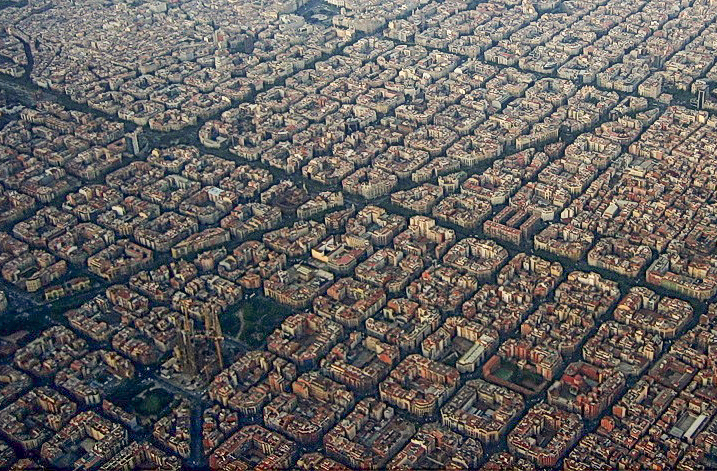
Photo by Travis Grossen on Unsplash
10 Oldest Buildings to visit in Barcelona
Barcelona is a European city with more than 2,000 years of history, it has a number of architecturally and historically significant and unique monuments.
Barcelona is an architecture lover’s playground, dotted with impressive Gothic structures and Modernist masterpieces.
Old Government buildings, mansions, churches and monasteries from the Middle Ages still survive in the old city centre.
The art and architecture movement from the turn of the 20th century — Catalan Modernisme — produced some of Barcelona’s most famous buildings, including Palau de la Musica Catalana and the still-unfinished Sagrada Familia.
Some of these iconic buildings were once actual homes and are now open to the public.
These are the 10 oldest buildings that not only define the Barcelona cityscape but also make you travel through time.
1. Cathedral of Barcelona
Year of construction: 1298 – 1448

Photo by Amin Safaripour on Unsplash
The Cathedral of the Holy Cross and Saint Eulalia also known as Barcelona Cathedral is the Gothic cathedral and seat of the Archbishop of Barcelona, Catalonia, Spain.
In the late nineteenth century, the neo-Gothic façade was constructed over the nondescript exterior that was common to Catalan churches.
The roof is notable for its gargoyles, featuring a wide range of animals, both domestic and mythical.
Barcelona Cathedral or Catedral de Barcelona is in the heart of the Gothic Centre, a prime location in the city. The stunning Gothic-style church is a must-visit when you’re in Barcelona.
2. La Sagrada Familia
Year of construction: 19 March 1882 (Foundation Stone)

Image by Peggy und Marco Lachmann-Anke from Pixabay
This monumental basilica is known in Spanish as “el Templo Expiatorio de la Sagrada Familia”, which literally translates to the “Expiatory Temple of the Sacred Family”.
Although the official starting date of work on the basilica is March 19, 1882, construction truly began over a year later on August 25, 1883.
Originally, it was architect Francisco de Paula del Villar who was in charge of the project, which he envisioned in a classic Gothic style.
Antoni Gaudí aged just 31 years old was commissioned for the job in 1883.
Gaudí completely changed the original project and began building his most famous work.
His style made him known worldwide as the master of modern architecture.
Gaudí aimed to build a universal masterpiece combining all symbols of Christianity.
The Sagrada Familia is an expiatory temple, it is a place made to commemorate the reparation of sins made against God or the laws of the Church.
Donations made by visitors and the public finances the construction which explains its slow progress.
Construction still continues today and its completion is scheduled for 2026, a date symbolic of the centenary of Antoni Gaudí’s death.
3. Reial Major Palace
Year of construction: Various Dates

Image by Jordiferrer from Wikimedia
A group of buildings in the Gothic quarter of Barcelona.
The Palau Reial Major is a complex of historic buildings located in Plaça del Rei, Barcelona, and Catalonia, Spain. It was a residence of the counts of Barcelona and kings of Aragon
The building is part of the Historical Museum of the City, a fascinating museum complex which takes visitors on a voyage through Roman, Visigothic and medieval Barcelona.
Two rooms stand out amongst the others inside the building: the Saló del Tinell, built by King Pedro el Ceremonioso between 1359 and 1362 and the 14th century Chapel of Santa Agata.
Salón de Tinell is a spectacular ceremonial area with many blind arches which use the old Roman wall; the Palatine Santa Ágata chapel containing the altarpiece of Constable Peter of Portugal by the artist, Jaime Huguet (1465), a masterpiece of Catalan Gothic painting; and the Lloctinent Palace, built in the 16th century by Antoni Carbonell for the king of Spain in a style between late Gothic and early Renaissance.
4. Saint James Square ( Placa de Sant Jaume)
Year of construction: 1369

Image by Herodotptlomeu from Wikimedia
The Plaça de Sant Jaume in English “Saint James’s Square”) is a square at the centre of the Old City of Barcelona and the administrative heart of both the city and surrounding Catalonia.
This is because the Palace of the Generalitat of Catalonia and the City Hall are located here across from one another.
This is Barcelona’s political hub. The Casa de la Ciutat, the seat of the municipal government and Palau de la Generalitat, home to the Autonomous Government of Catalonia sit on the square.
This beautiful stone-paved square is the site of important Catalan events, such as Castellers, the famous human towers.
Palau de la Generalitat is the result of various expansions and renovations lasting two centuries with Gothic, Renaissance and Baroque elements. It is only open to the public on 23 April.
The 14th century Casa de la Ciutat stands on the other side, note its splendid internal courtyard with Catalan Gothic stairway and the Salon de Cent, with its gigantic arches and the Salon de las Cronicas.
5. Carrer de Montcada
Year of construction: 1148

Image by Kippelboy from Wikimedia
The street called Carrer de Montcada is today the most important area of mediaeval civic architecture in the city.
Its name derives from the important Montcada family from Barcelona.
who, it appears, received the land in the 12th century for the support lent to King Ramon Berenguer IV by Guillem Ramon de Montcada during the conquest of Majorca.
At the end of the 19th and in the early 20th century, the street underwent significant alterations and a decline in the area’s residential nature.
The street was declared an artistic-historical heritage site in 1947.
this street has a special symbolic value. The old homes of Catalan noble families are located along this narrow street along with medieval or Renaissance buildings which are now home to important museums and art galleries including the Picasso Museum, Textile Museum, Barbier-Mueller Museum of pre-Columbian art and Maeght Gallery.
6. Eixample
Year of construction: 1859 – 1897

Image by Alhzeia from Wikimedia
In 1859, the construction of the Eixample neighbourhood began. Queen Elizabeth II kicked it off by placing the first stone of the Eixample in what we now know as Plaça de Catalunya.
Eixample is a large extension that Ildefons Cerdà designed for Barcelona in 1860.
It is a big area laid out on a grid system.
The area contains almost all of the modernista style buildings of the city, especially in the so-called “Quadrat d’Or”.
Between the 19th and 20th centuries, Barcelona’s upper class gave great impetus to this artistic movement which would make architects Gaudì like famous.
The streets of the centre have stylish boutiques, bars, and restaurants around iconic square Plaça de Catalunya.
Vendors sell their antiques under a mirrored roof at Mercat Els Encants flea market.
Master architect Antoni Gaudí designed the towering art nouveau basilica Sagrada Familía, and the rippled-stone mansion Casa Milà, which now hosts art exhibits and rooftop jazz concerts
7. Guell Palace (Palau Güell)
Year of construction: 1886 – 1888

Palau Güell (“Güell Palace”), by architect Antoni Gaudí. Barcelona, Spain Image by Simon Burchell from Wikimedia
It was the residence of Count Güell, Gaudì’s patron. In 1890 Gaudí designed an elegant and majestic building for Güell, which is the only private residence by Gaudì that can be visited in its entirety.
Industrial tycoon Eusebi Güell had architect Antoni Gaudí design it.
It is situated on the Carrer Nou de la Rambla, in the El Raval neighbourhood of Barcelona in Catalonia, Spain
8. Palace of Catalan Music
Year of construction: 1905 – 1908

Image by Cattzy from Wikimedia
Located in the El Born neighbourhood of Barcelona, the Palau de la Música Catalana is a historic concert hall famous for its eye-catching design.
One of the city’s many modernist landmarks, this turn-of-the-century masterpiece is possibly one of the most overlooked gems in the city
One of the most interesting parts is the impressive sculpture which unites the two facades, celebrating popular Catalan music.
But the most extraordinary room is the auditorium on the upper floor with its blue and gold ceiling and large sculptures. Guided tours every half hour, every day.
9. Casa de les Punxes (House of Spires)
Year of construction: 1905 – 1908

Image by Casa Punxes from Wikimedia
The Casa de les Punxes or Casa Terradas is a building designed by the Modernista architect Josep Puig i Cadafalch.
Located in the intersection between the streets of Rosselló, Bruc and the Avinguda Diagonal in the Barcelona Eixample
The pointed spires it has at the top give the building its name.
Puig i Cadafalch built this building by incorporating three houses which belonged to the Terrades sisters and thus created one united complex.
10. Milà House – La Pedrera
Year of construction: 1905 – 1908

Image by Roger Price from Wikimedia
Casa Milà, popularly known as La Pedrera (meaning “stone quarry” in Catalan), is Antoni Gaudí’s last civil work, which he started in 1906 and finished in 1912.
Casa Milà was designed by Gaudí between 1905 and 1910 as a building for apartments and offices.
It is called La Pedrera due to its appearance reminiscent of a stone quarry. The wavy forms and wrought-iron balconies on the facade create an impressive effect.
It has been on UNESCO’s World Heritage List since 1984.
Whether it’s inspiring architecture, mouth-watering cuisine that cool, Mediterranean atmosphere complemented by beautiful beaches. Barcelona is great to visit any time of year.

 English
English








